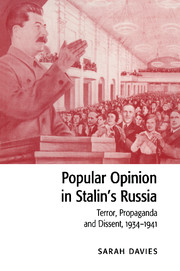Book contents
- Frontmatter
- Contents
- List of tables
- Acknowledgements
- Chronology
- List of abbreviations and archive references
- Glossary and notes on the text
- Introduction
- PART I ECONOMY AND SOCIETY
- PART II POLITICS AND TERROR
- 5 International relations
- 6 The Constitution and elections
- 7 The Great Terror
- 8 ‘Us’ and ‘them’: social identity and the terror
- PART III THE LEADER CULT
- Conclusion
- Notes
- Bibliography
- Index
6 - The Constitution and elections
Published online by Cambridge University Press: 25 March 2010
- Frontmatter
- Contents
- List of tables
- Acknowledgements
- Chronology
- List of abbreviations and archive references
- Glossary and notes on the text
- Introduction
- PART I ECONOMY AND SOCIETY
- PART II POLITICS AND TERROR
- 5 International relations
- 6 The Constitution and elections
- 7 The Great Terror
- 8 ‘Us’ and ‘them’: social identity and the terror
- PART III THE LEADER CULT
- Conclusion
- Notes
- Bibliography
- Index
Summary
Like international relations, constitutions and elections might seem an area remote from the concerns of ordinary people struggling to survive. However, the regime's intense agitprop campaigns on subjects such as the Stalin Constitution of 1936 and the ‘free and democratic’ elections which it inaugurated alerted at least some of the population to these issues. Yet people did not always interpret the propaganda in the intended manner. The show of ‘Soviet democracy’ did in fact provide a genuine forum for the expression of popular opinion and stimulate consciousness of civil and political rights.
THE CONSTITUTION
In reference to the emergence of a civil society in the USSR in the Gorbachev period, Geoffrey Hosking writes that ‘the first germ of civil society was contained in the Stalin Constitution of 1936’. He goes on to demonstrate how the rights it proclaimed were used by dissidents from the 1960s onwards. The aim of the following discussion is to show how this ‘germ’ was already sprouting small and fragile shoots in the period after 1936.
The draft version of the Stalin Constitution, approved by a party plenum in June 1936, differed significantly from its predecessors of 1918 and 1924. Whereas the latter provided for open elections and a class-based restricted franchise, the new Constitution introduced secret elections, open to all aged over eighteen, regardless of class background. It stressed the achievement of socialism and the harmony of classes, and that all power belonged to the workers and peasants.
- Type
- Chapter
- Information
- Popular Opinion in Stalin's RussiaTerror, Propaganda and Dissent, 1934–1941, pp. 102 - 112Publisher: Cambridge University PressPrint publication year: 1997



